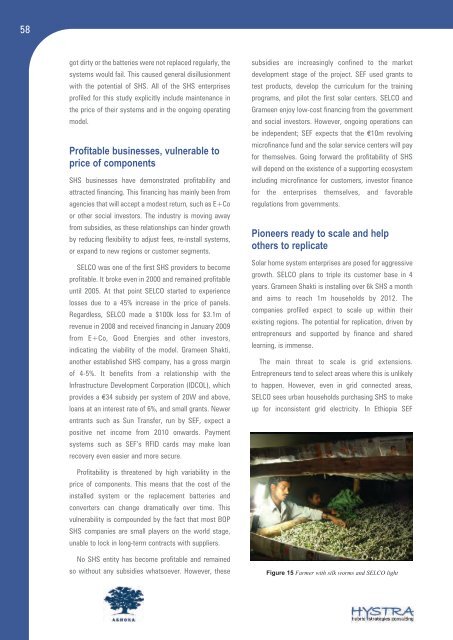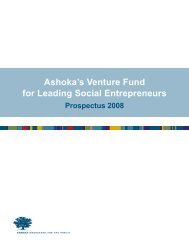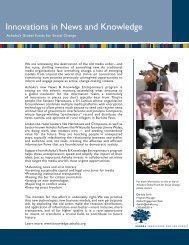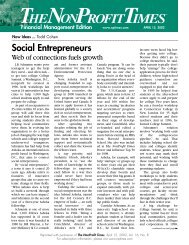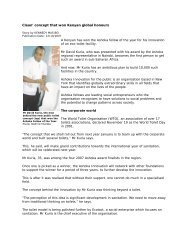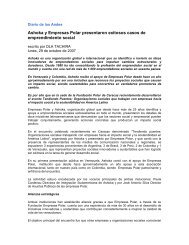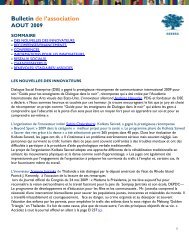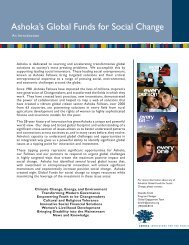Access to Energy for the Base of the - Ashoka
Access to Energy for the Base of the - Ashoka
Access to Energy for the Base of the - Ashoka
Create successful ePaper yourself
Turn your PDF publications into a flip-book with our unique Google optimized e-Paper software.
58<br />
got dirty or <strong>the</strong> batteries were not replaced regularly, <strong>the</strong><br />
systems would fail. This caused general disillusionment<br />
with <strong>the</strong> potential <strong>of</strong> SHS. All <strong>of</strong> <strong>the</strong> SHS enterprises<br />
pr<strong>of</strong>iled <strong>for</strong> this study explicitly include maintenance in<br />
<strong>the</strong> price <strong>of</strong> <strong>the</strong>ir systems and in <strong>the</strong> ongoing operating<br />
model.<br />
Pr<strong>of</strong>itable businesses, vulnerable <strong>to</strong><br />
price <strong>of</strong> components<br />
SHS businesses have demonstrated pr<strong>of</strong>itability and<br />
attracted financing. This financing has mainly been from<br />
agencies that will accept a modest return, such as E+Co<br />
or o<strong>the</strong>r social inves<strong>to</strong>rs. The industry is moving away<br />
from subsidies, as <strong>the</strong>se relationships can hinder growth<br />
by reducing flexibility <strong>to</strong> adjust fees, re-install systems,<br />
or expand <strong>to</strong> new regions or cus<strong>to</strong>mer segments.<br />
SELCO was one <strong>of</strong> <strong>the</strong> first SHS providers <strong>to</strong> become<br />
pr<strong>of</strong>itable. It broke even in 2000 and remained pr<strong>of</strong>itable<br />
until 2005. At that point SELCO started <strong>to</strong> experience<br />
losses due <strong>to</strong> a 45% increase in <strong>the</strong> price <strong>of</strong> panels.<br />
Regardless, SELCO made a $100k loss <strong>for</strong> $3.1m <strong>of</strong><br />
revenue in 2008 and received financing in January 2009<br />
from E+Co, Good Energies and o<strong>the</strong>r inves<strong>to</strong>rs,<br />
indicating <strong>the</strong> viability <strong>of</strong> <strong>the</strong> model. Grameen Shakti,<br />
ano<strong>the</strong>r established SHS company, has a gross margin<br />
<strong>of</strong> 4-5%. It benefits from a relationship with <strong>the</strong><br />
Infrastructure Development Corporation (IDCOL), which<br />
provides a €34 subsidy per system <strong>of</strong> 20W and above,<br />
loans at an interest rate <strong>of</strong> 6%, and small grants. Newer<br />
entrants such as Sun Transfer, run by SEF, expect a<br />
positive net income from 2010 onwards. Payment<br />
systems such as SEF’s RFID cards may make loan<br />
recovery even easier and more secure.<br />
Pr<strong>of</strong>itability is threatened by high variability in <strong>the</strong><br />
price <strong>of</strong> components. This means that <strong>the</strong> cost <strong>of</strong> <strong>the</strong><br />
installed system or <strong>the</strong> replacement batteries and<br />
converters can change dramatically over time. This<br />
vulnerability is compounded by <strong>the</strong> fact that most BOP<br />
SHS companies are small players on <strong>the</strong> world stage,<br />
unable <strong>to</strong> lock in long-term contracts with suppliers.<br />
No SHS entity has become pr<strong>of</strong>itable and remained<br />
so without any subsidies whatsoever. However, <strong>the</strong>se<br />
subsidies are increasingly confined <strong>to</strong> <strong>the</strong> market<br />
development stage <strong>of</strong> <strong>the</strong> project. SEF used grants <strong>to</strong><br />
test products, develop <strong>the</strong> curriculum <strong>for</strong> <strong>the</strong> training<br />
programs, and pilot <strong>the</strong> first solar centers. SELCO and<br />
Grameen enjoy low-cost financing from <strong>the</strong> government<br />
and social inves<strong>to</strong>rs. However, ongoing operations can<br />
be independent; SEF expects that <strong>the</strong> €10m revolving<br />
micr<strong>of</strong>inance fund and <strong>the</strong> solar service centers will pay<br />
<strong>for</strong> <strong>the</strong>mselves. Going <strong>for</strong>ward <strong>the</strong> pr<strong>of</strong>itability <strong>of</strong> SHS<br />
will depend on <strong>the</strong> existence <strong>of</strong> a supporting ecosystem<br />
including micr<strong>of</strong>inance <strong>for</strong> cus<strong>to</strong>mers, inves<strong>to</strong>r finance<br />
<strong>for</strong> <strong>the</strong> enterprises <strong>the</strong>mselves, and favorable<br />
regulations from governments.<br />
Pioneers ready <strong>to</strong> scale and help<br />
o<strong>the</strong>rs <strong>to</strong> replicate<br />
Solar home system enterprises are posed <strong>for</strong> aggressive<br />
growth. SELCO plans <strong>to</strong> triple its cus<strong>to</strong>mer base in 4<br />
years. Grameen Shakti is installing over 6k SHS a month<br />
and aims <strong>to</strong> reach 1m households by 2012. The<br />
companies pr<strong>of</strong>iled expect <strong>to</strong> scale up within <strong>the</strong>ir<br />
existing regions. The potential <strong>for</strong> replication, driven by<br />
entrepreneurs and supported by finance and shared<br />
learning, is immense.<br />
The main threat <strong>to</strong> scale is grid extensions.<br />
Entrepreneurs tend <strong>to</strong> select areas where this is unlikely<br />
<strong>to</strong> happen. However, even in grid connected areas,<br />
SELCO sees urban households purchasing SHS <strong>to</strong> make<br />
up <strong>for</strong> inconsistent grid electricity. In Ethiopia SEF<br />
Figure 15 Farmer with silk worms and SELCO light


